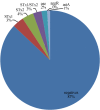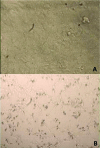Virulence profiles of Shiga Toxin-Producing Escherichia coli and other potentially diarrheagenic E.coli of bovine origin, in Mendoza, Argentina
- PMID: 24688508
- PMCID: PMC3958184
- DOI: 10.1590/S1517-83822014005000010
Virulence profiles of Shiga Toxin-Producing Escherichia coli and other potentially diarrheagenic E.coli of bovine origin, in Mendoza, Argentina
Abstract
This study described a group of strains obtained from a slaughter house in Mendoza, in terms of their pathogenic factors, serotype, antibiotype and molecular profile. Ninety one rectal swabs and one hundred eight plating samples taken from carcasses of healthy cattle intended for meat consumption were analyzed. Both the swab and the plate samples were processed to analyze the samples for the presence of virulence genes by PCR: stx1, stx2, eae and astA. The Stx positive strains were confirmed by citotoxicity assay in Vero cells. The isolates were subsequently investigated for their O:H serotype, antimicrobial susceptibility and molecular profile by Random Amplification of Polymorphic DNA (RAPD). Twelve E.coli strains were identified by their pathogenicity. Nine were from fecal origin and three from carcasses. Three strains carried the stx1 gene, three the stx2 gene, two carried eae and four the astA gene. The detected serotypes were: O172:H-; O150:H8; O91:H21; O178:H19 and O2:H5. The strains showed a similarity around 70% by RAPD. Some of the E.coli strains belonged to serogroups known for certain life-threatening diseases in humans. Their presence in carcasses indicates the high probability of bacterial spread during slaughter and processing.
Keywords: Enteroaggregative Stable toxin (EAST1); Enteropathogenic Escherichia coli (EPEC); Hemolitic Uremic Syndrome (HUS); Shiga Toxin Escherichia coli (STEC); cattle; foodborne diseases.
Figures




References
-
- Blanco M, Blanco JE, Mora A, Dahbi G, Alonso MP, Gonzalez EA, Bernardez MI, Blanco J. Serotypes, virulence genes, and intimin types of Shiga toxin (verotoxin)-producing Escherichia coli isolates from cattle in Spain and identification of a new intimin variant gene (eae-xi) J Clin Microbiol. 2004;42:645–51. - PMC - PubMed
-
- Gomez D, Miliwebsky E, Fernandez Pascua C, Baschkier A, Manfredi E, Zotta M, Nario F, Piquin A, Sanz M, Etcheverria A, Padola N, Parma A, Rivas M. Isolation and characterization of Shiga-toxin-producing Escherichia coli from frozen hamburgers and soft cheeses. Rev Argent Microbiol. 2002;34:66–71. - PubMed
-
- Hornitzky MA, Mercieca K, Bettelheim KA, Djordjevic SP. Bovine feces from animals with gastrointestinal infections are a source of serologically diverse atypical enteropathogenic Escherichia coli and Shiga toxin-producing E. coli strains that commonly possess intimin. Appl Environ Microbiol. 2005;71:3405–12. - PMC - PubMed
MeSH terms
Substances
LinkOut - more resources
Full Text Sources
Other Literature Sources
Medical
